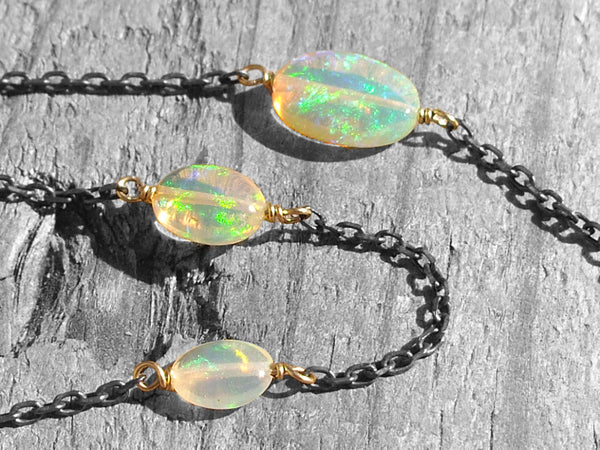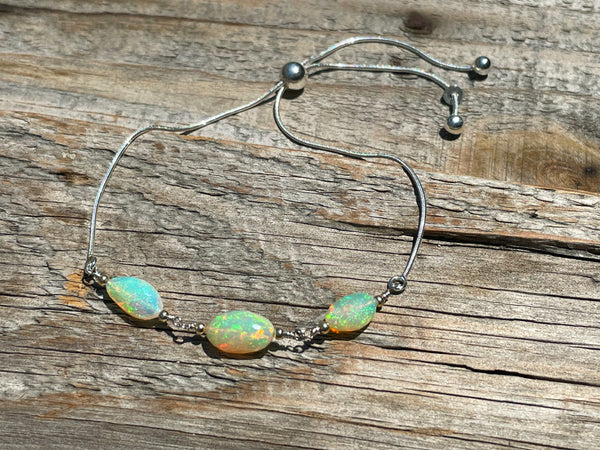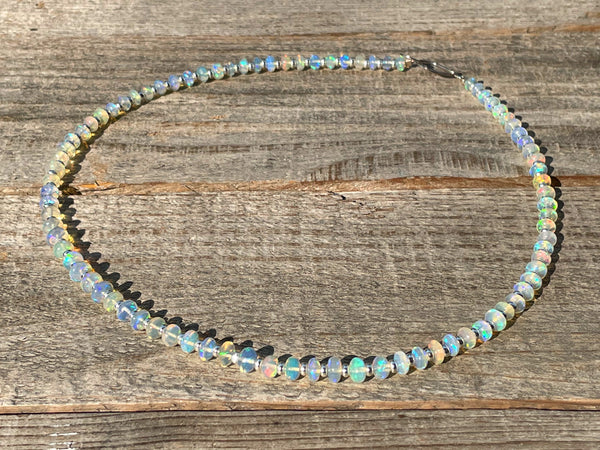Your Cart is Empty
FREE Shipping on all orders over $75
FREE Shipping on all orders over $75
Jewelry
Candles
Ethiopian Opal Jewelry - Buying Guide
April 11, 2020 9 min read
Our exclusive collection of women's Ethiopian Opal Jewelry can be found here: Ethiopian Opal Jewelry
Ethiopian Opal
Shop our exclusive collection of one of a kind Ethiopian Opal jewelry or read on for information about Ethiopian Opal, what to look for when buying jewelry with Ethiopian Opals, and information about Ethiopian Opal jewelry care.



The origin of Ethiopian Opal:
Ethiopian Opal, also known as ‘Welo Opal’ or Wollo Opal’, is a relatively new gem because even though it has existed for centuries, it was only more recently discovered in 2008 in the Stayish mine.
An earlier 1994 discovery of Ethiopian Opal at Yita ridge and Mezzezo in the Shewa province is sometimes confused with this significantly higher quality Welo Opal, however the two are vastly different. While Yita ridge Ethiopian Opals are known to be fragile, Welo Opals are a stable gem that is ideal for use in fine Ethiopian Opal jewelry, and do not usually crack or craze. In fact, the GIA has performed extensive tests on Ethiopian Welo Opals, including exposing them to water and intense heat, and has concluded that they are a stable gem that is unlikely to crack under extremes of conditions.
These Ethiopian Welo Opals are a variety of hydrophane Opal, which means that they absorb water and their color changes with water content from opaque to clear. In fact, Ethiopian Opals can contain up to 20% water. Hydrophane Opals originate from volcanic activity so if you’re looking for a particularly special piece of jewelry, a piece of jewelry with Opal created by an active volcano is hard to beat!
As Ethiopian Opal is relatively 'new', there is currently no industry wide accepted grading system for these gems. Unlike other Opals, the body tone or shade doesn't usually affect the grading or value of Ethiopian Opal.
How to tell if Ethiopian Opal is genuine:
Genuine Ethiopian Opals are often confused with artificial or fake gems. This tends to happen because this variety of Opal is particularly lightweight; much more so than other gems. Genuine Ethiopian Opals also have an almost waxy surface that feels somewhat like plastic, and of course the colors displayed in most of these Opals are so intense that it is often hard to believe that they are real Opals. The affordable price of Ethiopian Opal jewelry compared to other Opal types such as Australian Opal, also often leads people to believe that the Opal may be artificial.

Ethiopian Opal Colors:
Ethiopian Welo Opals are found in a transparent to white tone, and a transparent to yellow, tan or orange tone, in their natural state. These high quality Opals can display intense color flashes throughout in every color of the rainbow and from every angle (known as ‘precious Opal’), or, if a lower quality Opal, can display fewer or no color flashes (known as ‘common Opal’). Ethiopian Opals with great color can display a single color, several colors, or every color of the rainbow, so whether you want Ethiopian Opal jewelry with a single primary color, or, want the perfect ‘compliments everything’ piece of jewelry, Ethiopian Opal jewelry is perfect!
Ethiopian Opals are also found naturally in an opaque tan shade that often displays intense rainbow color flashes across its surface. These rare Opals are known as tan Opals or Chocolate Opal.
Black Ethiopian Opal is also found naturally however many of the Ethiopian black Opals seen in jewelry are in fact smoke treated transparent Opals. Genuine black Ethiopian Opal is usually a very intense dark color and this color remains consistent throughout the Opal when tests are performed on it, such as deliberately cracking the Opal open.
Recently, Ethiopian Opals have become available in a wide variety of colors such as black, blue, turquoise, green and even pink. These beautiful shades of Ethiopian Opal are color enhanced or smoke treated and as such are not natural, however they are extremely beautiful and just as stable as untreated Ethiopian Opals. These color enhanced Ethiopian Opals are still genuine Opal.
Ethiopian Opal color flashes can be displayed across the Opal's surface, internally within the gem, or a combination of both. They can be present as a large flash of color, multiple smaller flashes, or, tiny pin prick sized flashes of color (known as 'pinfire' Opal).
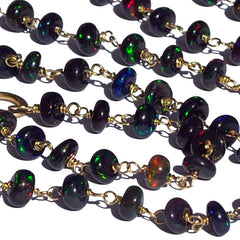

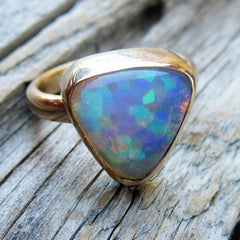
What cuts are available in Ethiopian Opal?
Ethiopian Opal is cut into cabochons (flat back and smooth domed surface) just like other Opal varieties, however unlike other types of Opal, it is often cut into ring stones in cuts that are usually reserved for gems like Diamonds. This is done because these Opals are usually transparent and a cut such as a ‘princess cut’ is able to show off the color play within the Opal in ways that a standard cabochon cut cannot. As such, Ethiopian Opals make great alternatives to Diamonds for contemporary and unusual engagement rings.
Ethiopian Opals are also often cuts into beads in a variety of shapes and sizes. These beads can vary massively in size, cut quality, and color quality. The most desirable and valuable Ethiopian Opal beads are those in a large size, a round cut, and with intense color flashes throughout in multiple colors.
How Much Does Ethiopian Opal Jewelry Cost?
Genuine Ethiopian Opal jewelry is surprisingly affordable, however, it won’t be forever. Other Opal varieties such as Australian Opal have now depleted their mines, causing a massive increase in price over the years. Ethiopian Opal is a relatively new Opal source discovery and currently the Ethiopian Opal mines have ample rough material to be mined and transformed into Opal gems. Eventually, this will change and the Ethiopian Welo Opal mines will become depleted just as others have, forcing an increase in both cost and value. This makes it a great time to invest in a piece of high quality Ethiopian Opal jewelry.
We’ve seen many questions in jewelry forums and social media over the years from people questioning the difference between pieces of Ethiopian Opal jewelry from different retailers and of the course the difference in price. To the untrained eye, the difference in quality may not be immediately apparent.
When looking at a piece of Ethiopian Opal jewelry, you should first look at the origin of the Opal; you want to ensure that it is Welo Opal and not Yita ridge Opal. Next you’ll need to look carefully at the cut of the Opal, particularly if the Opal is cut into beads. Are the Opal beads a consistent and uniform shape, or, are they mismatched and irregular in shape? Then look at the color, is it transparent or opaque? Does the Ethiopian Opal have lots of color flashes, and how many colors are displayed? How large is the Opal? Smaller Ethiopian Opals can be purchased at a relatively inexpensive price, however, larger Opals (larger than 4mm in bead form and larger than 6mm in other cuts) can be expensive.
The most valuable Ethiopian Opals are those with transparent color, a good even cut, a larger size, and intense color flashes throughout in every color of the rainbow.
The exception to this rule is patterned Ethiopian Opal. One of the most famous varieties of Ethiopian Opal with a natural pattern is Honeycomb Opal, which is a particularly rare type of Ethiopian Opal that displays cells of color across its surface that resemble a honeycomb pattern.
Fine quality Ethiopian Opals are comparable to the finest Australian crystal Opals and Mexican Fire Opals, yet are currently a fraction of the price of these gems.
When looking at jewelry with Ethiopian Opals, you should inspect it in a variety of lighting conditions, as this will massively affect the way that the Opal presents. Ethiopian crystal Opals look their best under strong sunlight and artificial lighting. Light and white background wash out the colors in Ethiopian Opal and so you’ll see Ethiopian Opal often photographed against a dark or black background when sold online. If you’re looking at a piece of Ethiopian crystal Opal jewelry indoors, you are unlikely to see the full display of color flashes that you will see if you look at the same Opal outdoors or under artificial lighting.

Ethiopian Opal Jewelry Care:
Even though Ethiopian Opal is more stable and suitable for use in jewelry than other Opal types, there are steps you can take to maintain your Opal jewelry. When cleaning your Opal jewelry, you should avoid chemicals of any type and simply use warm water and a non-abrasive cloth or sponge. Try not to use too much water, and if possible, simply use a damp cloth.
If your Ethiopian Opal gets wet, don’t worry. The color and transparency will change temporarily however it will revert to its original color as it dries over a few days.
You should avoid extremes of humidity and if you live in a desert climate with low humidity it is advisable to store your Ethiopian Opal jewelry in a small zip lock bag with a damp cotton ball to provide a little moisture and avoid it drying out. If you’d like us to supply you with a bag and cotton ball with your order then just ask!
Ethiopian Opal is more stable than other Opal varieties and it has been found to be able to withstand a drop from 4 feet onto a concrete floor without damage, so don’t panic if you accidentally catch your Ethiopian Opal jewelry on something or drop it.
Where to buy Ethiopian Opal Jewelry:
If you’d like to buy a piece of high quality jewelry with genuine Ethiopian Opals, it is important to do so from a trusted jeweler. Jewelers who specialize in Ethiopian Opal jewelry source their Opals from trusted suppliers and ensure that the cut, size and color is of the quality that you would want in your Ethiopian Opal jewelry. If a jeweler is unfamiliar with Opals from Ethiopia, they are likely to source unstable Yita ridge Opals, oblivious to the difference between Yita ridge Ethiopian Opal and Welo Ethiopian Opal. It is also more likely that your Opal jewelry will be made with high quality Ethiopian Opals if your jeweler is familiar with the gem and knows what to look for when sourcing these beautiful Opals.
It is also important to note that most Opal jewelry stores specialize in Australian Opal and their sales have been significantly impacted by the appearance of such high quality Opal, at a lower price, from a source outside of Australia. If you are reading reviews about Ethiopian Opal and its suitability for use in Opal jewelry, it is vital that you note the source of the review; if you see an article or review claiming that Ethiopian Opals aren't suitable for use in jewelry or aren't high quality, please check whether the company providing that (false) information specializes in selling a different type of Opal or has any incentive to persuade you to buy another type of Opal. Here at Biographie we love all types of Opal and although our personal favorite is Ethiopian Opal, we sell every type of Opal from Australian to Andean, and have no incentive to influence you to buy one type over another.
Often, jewelers selling Ethiopian Opal jewelry offer pieces of jewelry set with opaque gems displaying few color flashes, if any. In many cases the Opals that they use in their jewelry are a pale yellow tone or opaque white. If you are considering purchasing a piece of Ethiopian Opal jewelry it is wise to compare the quality of the jewelry offered by different retailers and shop around; don't assume that a large jewelry chain sells high quality Ethiopian Opal because they usually don't.
One trick that is used by some Ethiopian Opal jewelry retailers online is to alter the images of the Opal jewelry using photoshop or similar programs. This is done to highlight and exaggerate the color flashes within the Opals. Here at Biographie, we photograph our Ethiopian Opal jewelry in natural sunlight to provide you with an accurate representation of the Opal's color flashes and transparency.
Here at Biographie, we’ve been working with Welo Opals since they first hit the market in 2009; In fact, we were one of the first companies to work with this beautiful Opal variety. We know who to buy from (and who not to!), what to look for in these Opals, and how much to pay when sourcing these gems to ensure that our customers never overpay for quality Ethiopian Opal jewelry.
In fact, the quality of the Ethiopian crystal Opals we have worked with here at Biographie have far exceeded both the quality and price point of Opals we have incorporated into our designs from any other source; due to this, the vast majority of our Opal jewelry designs now feature Ethiopian Opals.
Our Ethiopian Opal jewelry designs feature only genuine Ethiopian Opals set into solid gold, sterling silver and gold vermeil (gold plated sterling silver). Due to the unique qualities of each Ethiopian Welo Opal gem, each of our jewelry designs is a one of a kind piece that can’t be recreated exactly so if you see a piece of genuine Ethiopian Opal jewelry in our collection that you love, be sure to pounce on it before someone else does!
Opal, known as the ‘Queen Of Gems’ is the birthstone for those born in October.
Shop our collection of genuine Ethiopian Opal jewelry and birthstone jewelry handmade with Ethiopian Opals.
All of the Ethiopian Opal jewelry designs featured in this buying guide are from our exclusive collection.

Related Products
Subscribe
Sign up to get the latest on sales, new releases and more …




